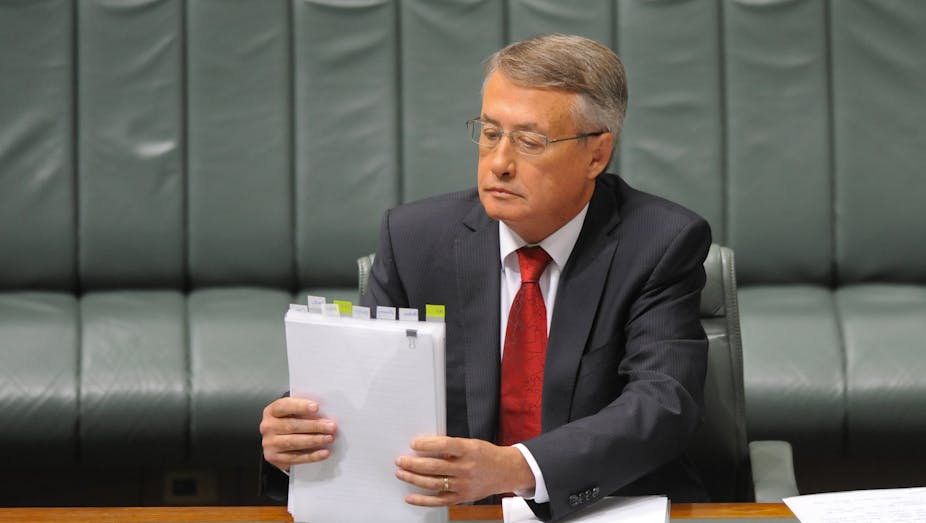It is just possible that the Federal Government’s public statements about the need to get back, at all costs, to a budget surplus for the 2012-13 year are based on a grim view of the intelligence of the average voter.
After all, so successful has the Opposition been in pursuing rank populism that the government must be tempted to think that there’s not much point in appealing to the higher ranges of the public’s conscientiousness.
But if populist motives of government ministers are not at the forefront of government thinking, and policy settings are rather a reflection of the thinking of the government or the Treasury on what is good policy, they give us a pretty grim picture of the intelligence of policy makers themselves.
It isn’t every day that a hard-nosed business consulting firm like Deloitte Access Economics reports that a small deficit is sensible policy, especially given the widespread recession of the global north. And yet, even in light of these circumstances, Treasurer Wayne Swan made it plain that the government plans to push ahead with budgeting for a modest surplus in the next financial year.
What’s wrong with this? Depending on the circumstances, it may turn out to be quite a mistaken policy stance that makes the problems of a recessionary world economy more severe.
Structural versus cyclical
To illustrate this we can look at the crucial difference between a cyclical deficit and a structural deficit.
A cyclical budget surplus or deficit comes about as a result of the business cycle. How much unemployment is falling (or rising) will determine how much government assistance is being called on, in the form of unemployment benefits as well as other benefits (such as health care).
The cycle will also determine how much government is able to collect in the form of taxation. In other words, a cyclical deficit can change – to become a larger deficit in a recession, or a smaller deficit or a surplus in a boom – without any policy changes being made.
A structural deficit (or surplus), on the other hand, is associated with deliberate policy decisions that push the financial bottom line to a position different from that which would have been generated by the business cycle itself.
During the global economic crisis of 2008 it was sensible to adopt looser fiscal policy, as the government did, so as to allow for more economic activity. This way, more people are kept in work than otherwise would be the case, with the aim being to get an economy back to a more desirable level of output and employment.
So, if an economy is judged to be at a desirable level of output, and there is a planned deficit, that deficit is structural. The same is true of a surplus. Of course there will be important political and social factors at play in what is considered a desirable level of output and employment.
Desirable output
If we take the last year in which Australia enjoyed full employment – 1974 – as our baseline, we can see that the country has now got a lower (that is, harsher) standard in terms of what we regard as desirable output. Policy makers have come to accept 5% unemployment as the norm.
The political economic significance of this in the present debate is that Australia’s fiscal policy stance (best gauged by looking at its structural deficits/surpluses, rather than cyclical effects) has been getting more removed from the economic circumstances of the time.
For example, in response to the brutal recession of 1990 it was very poor policy to run a tiny structural deficit in 1991/92 (of 0.8% of GDP). It would have been much wiser (and more humane) to run a significantly larger structural deficit of (say) 3% of GDP.
Should 5% unemployment be as good as it gets?
Of course, we have not touched on the composition of government outlays and revenues, which is also a legitimate area of political economic debate. Even if government policy makers genuinely believe that a surplus is consistent with maintaining an unemployment rate of, say, 5%, all sorts of arguments can still ensue about a more just distribution of outlays and fairer rates of tax. Several forms of expenditures on the wealthy, for example, can very easily be questioned on grounds of both equity and efficiency.
The Howard Government, were it ever genuine in its belief about the need to run a surplus, and given it wasn’t interested in reducing unemployment, should have been running much larger surpluses from about 2003, given the economic circumstances of the mining boom.
Given how well Swan responded to the economic crisis, it is somewhat surprising and concerning that he is locking himself into a stance that may turn out to be irresponsible.
It seems we can’t escape the conclusion that Swan is making a judgment either that 5% unemployment is as good as it gets – that that is where the baseline is now to be set in terms of fiscal policy – or that if unemployment is pushed higher by world events, we shouldn’t expect the enlightened approach we saw last time round.

